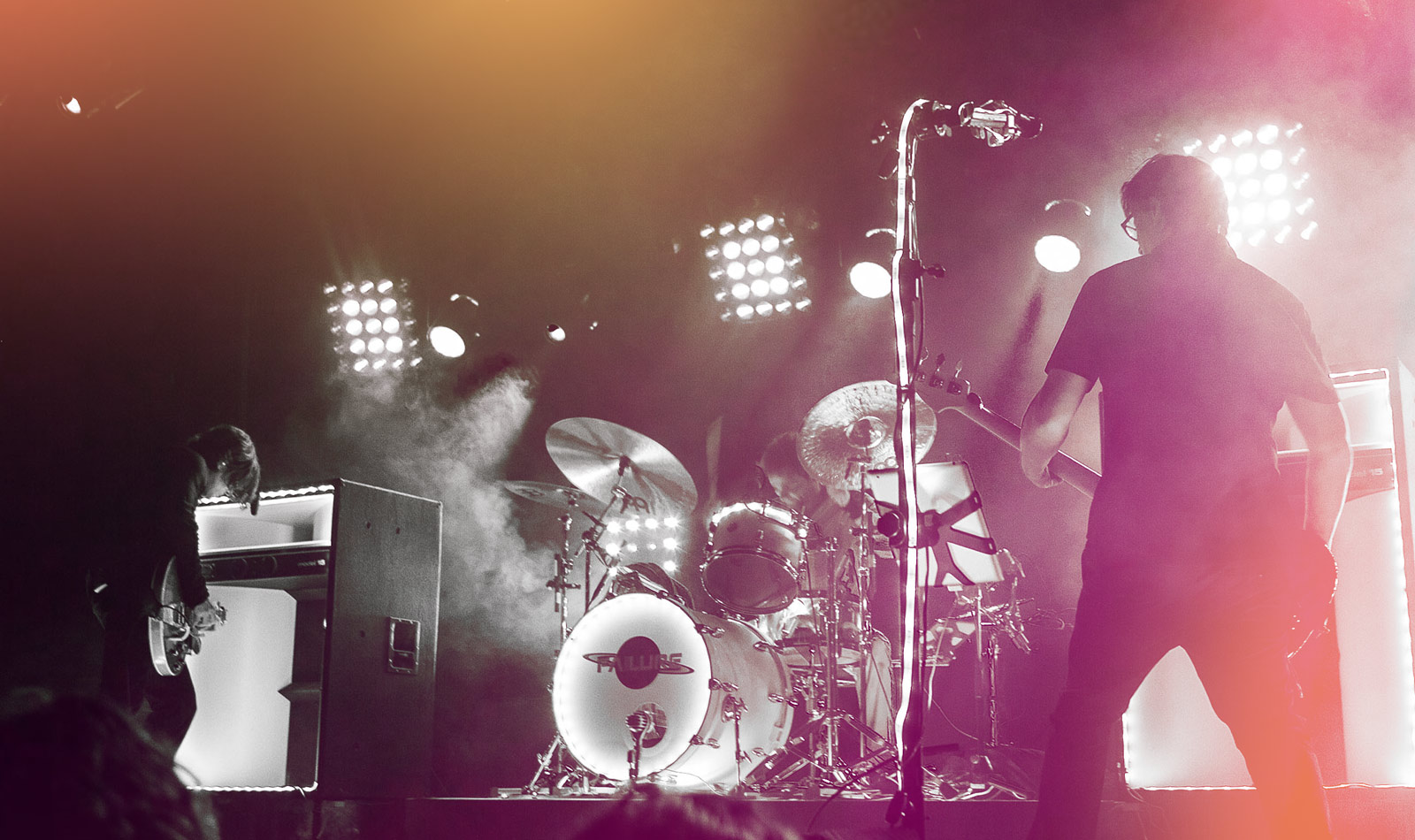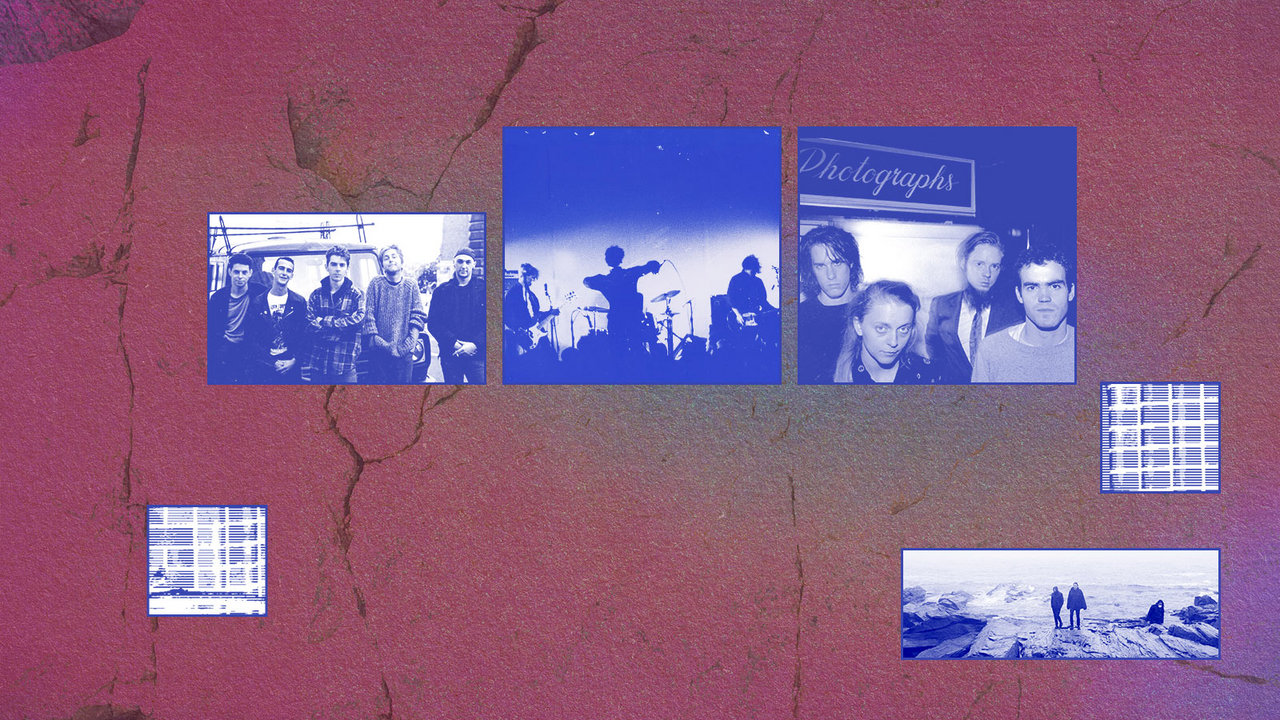
To give you an idea of just how much has changed in the three decades since Failure became a band, the two co-founders—frontman Ken Andrews and multi-instrumentalist Greg Edwards—first connected via landline, after Edwards responded to a classified ad in the California paper The Recycler.
“Ken was by far the most serious musician I had met at that point,” explains Edwards, “and more importantly, he was very good at charting practical steps on the way to a goal. We had artistic respect for each other immediately, but it wasn’t like we were natural born friends. Our friendship was really peripheral to our working relationship.”
That meant they could leave any lingering personal baggage at the door of their downtown L.A. space and instead focus on what Failure’s raw sound would be. When Edwards first joined the group, Andrews and their original drummer (Robert Gauss) already had a small batch of songs sketched out on a four-track, including the runaway guitar riffs and sucker-punch percussion of “Pro-Catastrophe.”
Other early standouts (the shadowy A-side “Count My Eyes,” the slow-but-steady build of “Screen Man,” the mud-slinging melodies of “Macaque”) emerged as the months went on, and the trio found they were all marching to the same offbeat drum.
“We were in love with the darkness and tension,” says Edwards, “and each of us was consciously steering around convention. Once we started playing shows a few months later, we were able to feel what really had power and translated to an audience. We took this knowledge back to the rehearsal space and started writing things that would be dynamic in a club while still maintaining the unique atmosphere we already had.”

A lot of this was lost on casual listeners and critics who couldn’t help comparing Failure to Nirvana. After all, this was the early ‘90s, an era dominated by Alternative Nation also-rans and dime-a-dozen grunge bands like Sponge, Candlebox, and Bush. Failure always had more in common with the caustic power chords of noise rock, the hi-fi heaviness of shoegaze, and slightly mad sci-fi movies.
“I used to have an allergic reaction to terms like ‘grunge,’ because they carried no meaning for me in relation to our music,” explains Edwards. “But I’ve accepted that humans can’t resist categorizing, no matter how reductive and inaccurate. If you actually like music, you know how useless categories are beyond positioning a band in time and proximity to their peers.”
To help put Failure’s entire career in perspective on the eve of a month-long North American tour and a self-titled documentary that’s set to premiere in 2023, we asked Edwards to walk us through their widescreen discography, including the three peak-of-their-powers LPs they’ve released since reuniting in late 2013.
Comfort


Failure’s two favorite records when they signed with Slash—one of the first indie labels to sign a distro deal with a major—were The Breeders’s Pod and The Jesus Lizard’s Goat, so booking a session with Steve Albini seemed like a no-brainer for their own debut. Edwards says, “recording with Steve was a true learning experience on multiple levels,” including the make-or-break fact that he’s more of a fly-on-the-wall documentarian than someone who’s “there to make you sound better than you do.”
“An album like Goat captures a band at the height of its powers,” explains Edwards, “and that’s the intersection where Albini’s technique really works. We were too inexperienced as a live band to take advantage of that. Ken and I were also starting to realize how important the production element of a recording—really sculpting every aspect of the listening experience—was to us. It quickly became apparent that recording our first record with someone who wouldn’t even accept a ‘produced by’ credit on principle was probably a mistake.”
One thing they did enjoy was the idyllic space (Pachyderm Recording Studio in Cannon Falls, Minnesota) where Comfort was made—the very same rural environment that produced Rid of Me, In Utero, and the recent Beach House record Once Twice Melody. “It was an amazing place to record and live for a few weeks,” says Edwards. “It had an indoor pool and sauna, paths leading into the forest all around the property, deer at my window every morning when I woke…[and] Steve Albini seemed to always be grilling huge cuts of meat on the patio while wearing his Jeffrey Dahmer t-shirt. Everything was perfect, except for what we were hearing back through the speakers.” Andrews eventually righted these wrongs by remixing the entire record and ending up with a director’s cut that Edwards insists is “louder and richer and objectively better.” It’s now available on Bandcamp, along with a revamped version of the next record…
Magnified
Quite a bit happened in the lead-up to Failure’s second LP. For starters, Edwards and Andrews became roommates and started writing side-by-side for the first time. Ambitious in ways that wouldn’t be fully appreciated until years later, they suddenly left one set of north stars—Sonic Youth, My Bloody Valentine, and The Jesus Lizard—behind in favor of bands like the Beatles, Pixies, and The Cure. “We wanted to make an album of undeniable songs,” explains Edwards, providing the explosive passages of “Bernie” as an example. “We were pretty excited about it, but when we played it for Robert, he was visibly unimpressed with what he perceived as a ‘poppier’ direction.”
Gauss decided to leave the band well before they hit the studio with Magnified in hand. This didn’t surprise or deter the duo he left behind; according to Edwards, he and Andrews merely, “kept charging ahead with new ideas and discovered a really effective way to work where we could trade off instruments from section to section as we composed. We were both writing lyrics and melodies and playing bass and guitar. It was a very productive, creative time.”
The album’s pyrotechnic drum patterns were programmed with a drum machine as Failure worked on each song. When a new drummer came in at the start of the sessions and had trouble executing his parts, Edwards stepped in as a pinch hitter to make sure the entire affair would end up the way they envisioned it. “We were much happier with Magnified,” he says. “For us, production was really just the final stage of songwriting, so it made total sense for us to be in control of that as well. I feel like it helped us achieve the color and the drama of the songs.
He continues, “More importantly, it sounded like no one else. Comfort seemed like a black and white film in comparison. ‘Small Crimes’ was a song that really sewed it up for me and opened up a world of possibility.”

Fantastic Planet
If Magnified was a portal of what Failure could be, Fantastic Planet was the point where they walked right through and brought a new drummer (longtime co-conspirator Kellii Scott) along for the ride. “His personality was a perfect addition,” says Edwards. “He has a very positive energy, is eternally hopeful, and almost always hilarious—a perfect balance to the brooding intensity that Ken and I could sometimes cast over a room.”
He was also fine with following the pair down whatever path they felt was right at the time. For Fantastic Planet, that meant living and working in a house that once belonged to Lita Ford, and stitching each sequence together from start to finish. Edwards also discovered heroin, a drug that was pervasive within L.A.’s music scene in the ‘90s. “At the beginning of the process, I had fallen into a pretty deep immobilizing depression,” he says, “and felt utterly incapable of rising to the moment and making the record. I chose heroin as a way out of my funk. Unfortunately, it worked like a charm and gave me a perspective from which to write lyrics from: outer space.”
The stargazing balladry of “Blank” helped set the album’s tone and open a metaphorical door—“a coded experience of depression and drug use”—on the subject matter side of things. Meanwhile, the name Fantastic Planet was a nod to the French animated film La Planète Sauvage (1973), one of several cult classics that were a constant presence throughout the creative process. (The song “Solaris” was actually modeled after what Robert Smith did with the Camus-inspired song “Killing an Arab.”) While it’s now considered a pinnacle of Failure’s career, and mid-’90s modern rock in general, Fantastic Planet also marked the moment where Edwards left this particular astral plane entirely. “I was somewhere else,” he says, “and I’m sure that the fact that this is my memory of that period equaled a lot of frustration for my bandmates. Ken made the decision to break up the band. I was in no state to make a decision about anything. That’s precisely why he made the choice he did.”
The Heart is a Monster
Seven years, one compilation (Golden), and countless outside projects later (including Autolux, Digital Noise Academy, and Andrews’s impressive run as a producer), Failure decided to put the past behind them and start working on new material. “Come Crashing” was a sign of the LP that loomed on the horizon, a triumphant guitar progression Edwards had written and shelved right after the group broke up. “It’s fitting that it was the first thing we worked on,” says Edwards. “It definitely became apparent that Ken and I hadn’t missed a beat in terms of collaborating. It was like that expanse of time just collapsed and we fell right back into it.”
They weren’t about to “regain a former glory or fall into any past song formulas,” however. “We put a lot of pressure on ourselves when we came back,” explains Edwards. “I kept saying to myself and the other guys, ‘If it’s not exceptional when we get going, we just need to walk away.’ I really was ready to jump ship if I thought it was going to be lame. By the time we had finished ‘Come Crashing,’ most of those fears had been quelled.”
In the Future Your Body Will Be the Furthest Thing From Your Mind
Once it became clear that Failure’s ‘reunion’ was actually the second phase of a long career, the band decided “to interface with the flea-length attention span of culture” by spreading their next full-length over four distinct EPs. The seemingly endless album title In the Future Your Body Will Be the Furthest Thing From Your Mind reflects their individual titles, and a phrase Edwards wrote on a dry erase board during The Heart is a Monster. Scott had remembered and suggested it. As for how Edwards feels about Album No. 5’s prolonged release: “I think the record would have been served better all around if it had been released all at once,” he says. “Of course, the only way you end up with that exact group of songs is to record and release it exactly the way we did, because the process dictated how we worked and the kind of ideas we pursued. It would have been a very different record if we had recorded it from start to finish in one go.”
One thing that holds the whole thing together is the “feeling of unraveling” that Edwards was starting to notice on social media and couldn’t seem to escape. “We love to hate what we hate and love what we love,” he says. “It gives me a helpless, hopeless feeling. We’re so vulnerable and terrified down here on this tiny ball, and we just don’t have the capacity to pull it together because our evolutionary programming moves in the opposite directions of what could bring us together and save us.”
Wild Type Droid
Which brings us to the incredibly focused record Failure wrapped and released last year. Between its 10 tightly edited tracks and sheer lack of signature instrumental segues, you’d never know that Wild Type Droid started with 30 hours of sprawling improv sessions. Andrews cut this down to just three. Favorite moments and sections were then expanded into proper songs.
“One of the happiest accidents,” says Edwards, “was that on the three-hour, best-of edit, the jam that turned into ‘A Lifetime of Joy’ just happened to come right before the jam that became ‘Submarines.’ When I heard that transition, I suddenly had a better idea about what kind of record it would be and what songs might come before and after. I also really like the arrangement for ‘Headstand’; there is no way I would ever play something that sparse and simple unless I was lost in the middle of an endless jam.”
When asked about what the final version of Wild Type Droid says about how Failure works, Edwards replies, “I really enjoyed the process because ultimately songwriting is all curation. I think it’s cool when you aren’t only choosing from intentional moments where you are consciously trying to write a song. You find those moments where your conscious mind was turned off or at least turned down, and that’s when some of the best stuff happens.”








